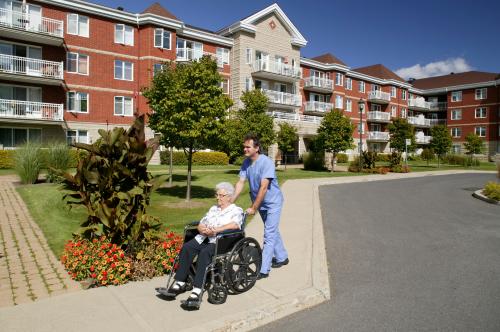Editor’s note: The post originally appeared on the JAMA Forum.
The daunting potential cost of long-term care is an increasing worry for aging baby boomers, as well as for lawmakers concerned about the growing costs of Medicaid and other government programs—for good reason.
Although most older adults in the United States will not experience a lengthy period living in a nursing home or using intensive home supports, an estimated 70% will need some level of long-term supports and services (LTSS). Given that nursing facilities cost on average nearly$90,000 per year and the average yearly cost for home health care tops $45,000, those individuals who need lengthy care face catastrophic financial costs.
Many people in the United States assume that nursing home and LTSS costs are covered by Medicare, but generally they are not. That means that many elderly and disabled people depend heavily on family caregivers, and they have to exhaust their savings before Medicaid, which does cover long-term care, kicks in. Because Medicaid already covers half of LTSS costs, fears are rising about the long-range financial condition of that federal-state program. So it’s little wonder that the Obama Administration identified LTSS as a priority theme for the White House Conference on Aging on July 13, 2015.
Political Setbacks, New Efforts
Although these growing problems have been recognized for years, the US political system has been unable to tackle them decisively. A modest, new long-term care program known as the Community Living Assistance Services and Supports Act (CLASS Act) was added to the Affordable Care Act, but it was deemed unworkable by the Administration and abandoned before it was even launched. Moreover, the 2013 Commission on Long-Term Care was unable to reach agreement and splintered, leading to an official report and an alternative one.
Fortunately these political setbacks sparked a number of efforts to draw together bipartisan groups of individuals or organizations to try to build a strong consensus from the ground up on how to address the financial challenge of LTSS costs. The aim is to find a solution that is affordable both for individuals and for the nation’s finances, and that can win broad political support.
One such effort is being undertaken by the Bipartisan Policy Center, a think tank launched in 2007 by Democratic and Republican former US senators. Another effort, called the Long-Term Care Financing Collaborative, is guided by the Convergence Center for Policy Resolution. That initiative has brought together a wide range of individuals and stakeholder groups, including representatives of such organizations as AARP, LeadingAge, Families USA, America’s Health Insurance Plans (AHIP), and such think tanks as the Brookings Institution, the Center on Budget and Policy Priorities, and the Urban Institute. Convergence uses the techniques of facilitated dialogs to build trust and find common ground. (Disclosure: I serve on the board of Convergence).
The Long-Term Care Financing Collaborative recently unveiled a set of principles agreed by its members. Among the principles:
- Older US adults and younger people with impairments must be enabled to live as independently as possible with the maximum choice of settings for receiving LTSS services.
- Family caregivers need much greater support.
- Health services need to be much better integrated with family-centered and community-centered services and supports.
- People need much better access to affordable public or private insurance, with any public program or public support fiscally sustainable.
The Collaborative is currently engaged in developing proposals that can potentially win broad support.
Reducing Overmedicalization
There appears to be growing consensus that much care in the United States is “overmedicalized.” As the Collaborative pointed out, medical care and LTSS need to be better integrated, especially services centered on the home.
Achieving this means reviewing licensing and payments systems for social service workers, home aides, nurses, and others so that families needing help can get it from the most appropriate team at a reasonable cost. It also means governments need to review budgets for transportation, housing, and other nonhealth services, and use waivers and other strategies to make it easier to better integrate these services with a person’s health care needs.
Stabilizing Insurance
Another area of focus is insurance. Trying to insure against the potential cost of LTSS is becoming increasingly difficult as fewer insurers offer policies and premiums are rising sharply. One reason for this is that most younger US adults do not realize the need for such protection when it is still affordable for them. Insurers also report a double whammy: low interest rates that mean they earn less investing premiums and an unexpectedly high proportion of policyholders holding onto their policies and eventually collecting when they need long-term care. That combination makes business riskier for insurers and policies more expensive.
Stabilizing private insurance will not be easy. One solution might be to replace private insurance with a new Medicare-style public coverage financed with a payroll tax. But as the CLASS Act debacle showed, designing an actuarially sound program is difficult. Moreover, given the bleak long-term financing picture for Medicare, many lawmakers would resist creating a new social insurance program.
An alternative, which may gain support, would be to make long-term care insurance more of a hybrid. Under some proposals, government reinsurance would take over the heavy and uncertain long-term costs facing insurers, and premium subsidies would help younger people to afford coverage. Some private insurers say they are open to some form of hybrid as a solution. The challenge for subsidized hybrid policies is whether they can balance the goal of affordability to families but also to taxpayers.
Revamping Medicaid
A third area where consensus is being sought is Medicaid’s role in LTSS. Designed originally as an acute care program for the poor, the increasing cost of LTSS has meant that even once–middle-class individuals with high LTSS costs exhaust their savings and are then forced to depend on Medicaid. Members of the Long-Term Care Financing Collaborative and others are exploring how to redesign or expand the program to provide a more effective and appropriate public safety net for older or disabled individuals.
Finding consensus in these areas will not be easy, and it will take time. But the good news is that insurers, organizations representing elderly and disabled people, and public policy experts are now coming together to try to agree on solutions.









Commentary
JAMA forum: Coming together on long-term care
July 15, 2015